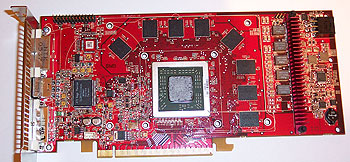ATI Radeon X1800 XT Reference Board Examination
Unless you've had your broadband disconnected for the last couple of months, or you've got not interest in new 3D graphics products before they launch (and to be fair, it is the realm of the deranged to talk such things up on online forums or websites *cough*), you'll have caught glimpse of the Radeon X1800 XT and its somewhat controversial cooler.I even broke my own shaky "I don't engage in rumour mongering" stance not long ago, after our article on the Avivo display and video engine that's part of ATI R5-series silicon, with some spy shots of X1800 XT and X1800 XL in action during the London Avivo demo.
The reference board is a little bit different to what you might have seen around, making it worth a good look.
Ruby - star of an upcoming demo by RhinoFX that ATI commissioned to show off the new graphics hardware, and prior star of demos showcased for R4-series silicon - adorns the large heatsink cover. Physically, the board is as long as current NVIDIA GeForce 7800 GT and GTX reference PCBs and, as you can see, needs an external power feed via the now-standard 6-pin port despite the ability to draw a fair amount of current over the PCI Express slot. ATI choose digital VRMs for power management into the board, the red aluminium heatsink covering those switching devices.
The dual-slot heatsink and fan style on the lard-arsed 692 gram board is roughly the same as what you'll find on a reference Radeon X850 XT Platinum Edition, but with some important differences that we'll go over shortly.
The rear view of the board underlines its size, the left hand side of the photograph showing you the extra length you have past the end of the PCI Express slot. The retention mechanism for the heatsink and fan assembly is clear to see; a padded bracket screws to the four mounting holes that appear through the holes in the PCB. The heatsink pressure this affords appears to be larger than the pressure applied by the X850 XT Platinum Edition's heatsink on its R480 or R481 GPU. Four other screws retain the larger area of the one-piece heatsink assembly.
Dual DVI ports are clear to see, each one a dual-link port driven by the GPU's internal TMDS transmitters and RAMDACs.
Nude, you can see the Rage Theater 200 ASIC used for video capture and processing, feeding the R520 GPU via a dedicated input. The eight Samsung K4J52324QC GDDR3 DRAM devices are actively cooled by the heatsink via thermal pads. Each 512Mib device occupies one of the memory channels to the ring bus memory controller, the BJ12 variant parts rated to 800MHz with 2.0V input.
The pin array at the top left of the board looking at that photograph has an unknown function, but it's not for Crossfire inter-GPU communication, so HEXUS are told.
Note that we're showing A11 silicon, rather than the silicon revision of the board being photographed. The die is 16x18mm in size for a 288mm² area, housing just over 300 million transistors.
Heat and noise
Sadly, and while not as bad as the Radeon X850 XT Platinum Edition, the board is hot and it is noisy. At the full fan speed you experience at first boot, the cooler is loud and bothersome, whining at a constant pitch with a decibel level to make even my deaf old ears prick and take notice. Shortly after it reverts to temperature controlled mode. The steppings from slowest speed (it never stops completely) upwards towards full speed aren't analogue, the stepped pitch changes of what appears to be a digital control making the transition to higher or lower speeds noticeable.At the first three intermediate speeds the noise is tolerable to this reviewer, anything above that increasingly less so. It certainly makes more noise than a reference NVIDIA GeForce 7800 GTX to cool the GPU, on average under regular gameplay loads. The heatsink and fan do work together to efficiently exhaust the heat from your chassis, as all good graphics board heatsinks really should, given the limitations that ATX and BTX compliance force on the board's design.
Heat produced is sizeable, but unlike Radeon X850 XT Platinum Edition where the rear of the board would get very hot and dump heat into your chassis, the pressure of the heatsink on the GPU seems to allow the sink to remove most of the heat in the right way for the fan to push out, after it's exchanged to the local air pulled through the heatsink's fins. It's worth pointing out that the fins on the sink appear to be skived in the way they are on the X850 XT PE cooler, which makes the copper mass more efficient, the fins physically part of the copper base, not joined artificially in any way.
I'm no fan of the noise made, but everything else is pleasing. Two slots makes little difference these days, although occluding a slot on your mainboard - if indeed your mainboard model has one in the space - is never desirable.













